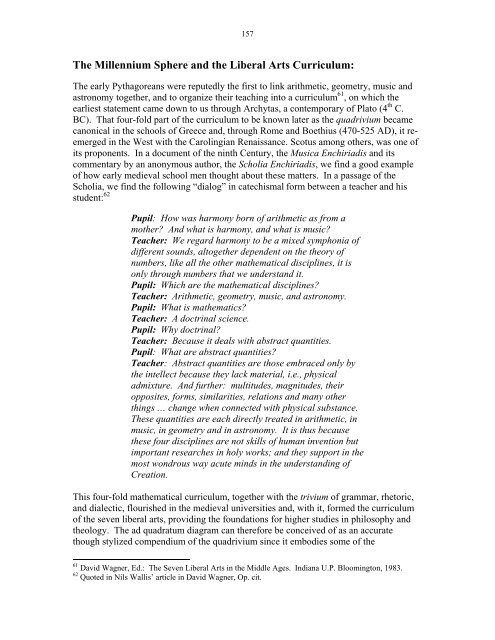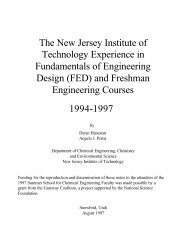Ad Quadratum Construction and Study of the Regular Polyhedra
Ad Quadratum Construction and Study of the Regular Polyhedra
Ad Quadratum Construction and Study of the Regular Polyhedra
You also want an ePaper? Increase the reach of your titles
YUMPU automatically turns print PDFs into web optimized ePapers that Google loves.
157<br />
The Millennium Sphere <strong>and</strong> <strong>the</strong> Liberal Arts Curriculum:<br />
The early Pythagoreans were reputedly <strong>the</strong> first to link arithmetic, geometry, music <strong>and</strong><br />
astronomy toge<strong>the</strong>r, <strong>and</strong> to organize <strong>the</strong>ir teaching into a curriculum 61 , on which <strong>the</strong><br />
earliest statement came down to us through Archytas, a contemporary <strong>of</strong> Plato (4 th C.<br />
BC). That four-fold part <strong>of</strong> <strong>the</strong> curriculum to be known later as <strong>the</strong> quadrivium became<br />
canonical in <strong>the</strong> schools <strong>of</strong> Greece <strong>and</strong>, through Rome <strong>and</strong> Boethius (470-525 AD), it reemerged<br />
in <strong>the</strong> West with <strong>the</strong> Carolingian Renaissance. Scotus among o<strong>the</strong>rs, was one <strong>of</strong><br />
its proponents. In a document <strong>of</strong> <strong>the</strong> ninth Century, <strong>the</strong> Musica Enchiriadis <strong>and</strong> its<br />
commentary by an anonymous author, <strong>the</strong> Scholia Enchiriadis, we find a good example<br />
<strong>of</strong> how early medieval school men thought about <strong>the</strong>se matters. In a passage <strong>of</strong> <strong>the</strong><br />
Scholia, we find <strong>the</strong> following “dialog” in catechismal form between a teacher <strong>and</strong> his<br />
student: 62<br />
Pupil: How was harmony born <strong>of</strong> arithmetic as from a<br />
mo<strong>the</strong>r? And what is harmony, <strong>and</strong> what is music?<br />
Teacher: We regard harmony to be a mixed symphonia <strong>of</strong><br />
different sounds, altoge<strong>the</strong>r dependent on <strong>the</strong> <strong>the</strong>ory <strong>of</strong><br />
numbers, like all <strong>the</strong> o<strong>the</strong>r ma<strong>the</strong>matical disciplines, it is<br />
only through numbers that we underst<strong>and</strong> it.<br />
Pupil: Which are <strong>the</strong> ma<strong>the</strong>matical disciplines?<br />
Teacher: Arithmetic, geometry, music, <strong>and</strong> astronomy.<br />
Pupil: What is ma<strong>the</strong>matics?<br />
Teacher: A doctrinal science.<br />
Pupil: Why doctrinal?<br />
Teacher: Because it deals with abstract quantities.<br />
Pupil: What are abstract quantities?<br />
Teacher: Abstract quantities are those embraced only by<br />
<strong>the</strong> intellect because <strong>the</strong>y lack material, i.e., physical<br />
admixture. And fur<strong>the</strong>r: multitudes, magnitudes, <strong>the</strong>ir<br />
opposites, forms, similarities, relations <strong>and</strong> many o<strong>the</strong>r<br />
things … change when connected with physical substance.<br />
These quantities are each directly treated in arithmetic, in<br />
music, in geometry <strong>and</strong> in astronomy. It is thus because<br />
<strong>the</strong>se four disciplines are not skills <strong>of</strong> human invention but<br />
important researches in holy works; <strong>and</strong> <strong>the</strong>y support in <strong>the</strong><br />
most wondrous way acute minds in <strong>the</strong> underst<strong>and</strong>ing <strong>of</strong><br />
Creation.<br />
This four-fold ma<strong>the</strong>matical curriculum, toge<strong>the</strong>r with <strong>the</strong> trivium <strong>of</strong> grammar, rhetoric,<br />
<strong>and</strong> dialectic, flourished in <strong>the</strong> medieval universities <strong>and</strong>, with it, formed <strong>the</strong> curriculum<br />
<strong>of</strong> <strong>the</strong> seven liberal arts, providing <strong>the</strong> foundations for higher studies in philosophy <strong>and</strong><br />
<strong>the</strong>ology. The ad quadratum diagram can <strong>the</strong>refore be conceived <strong>of</strong> as an accurate<br />
though stylized compendium <strong>of</strong> <strong>the</strong> quadrivium since it embodies some <strong>of</strong> <strong>the</strong><br />
61 David Wagner, Ed.: The Seven Liberal Arts in <strong>the</strong> Middle Ages. Indiana U.P. Bloomington, 1983.<br />
62 Quoted in Nils Wallis’ article in David Wagner, Op. cit.




